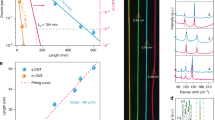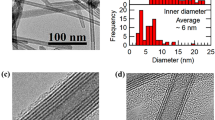Abstract
Transition metal dichalcogenide (TMD) nanotubes offer a unique platform to explore the properties of TMD materials at the one-dimensional limit. Despite considerable efforts thus far, the direct growth of TMD nanotubes with controllable chirality remains challenging. Here we demonstrate the direct and facile growth of high-quality WS2 and WSe2 nanotubes on Si substrates using catalytic chemical vapour deposition with Au nanoparticles. The Au nanoparticles provide unique accommodation sites for the nucleation of WS2 or WSe2 shells on their surfaces and seed the subsequent growth of nanotubes. We find that the growth mode of nanotubes is sensitive to the temperature. With careful temperature control, we realize ~79% WS2 nanotubes with single chiral angles, with a preference of 30° (~37%) and 0° (~12%). Moreover, we demonstrate how the geometric, electronic and optical properties of the synthesized WS2 nanotubes can be modulated by the chirality. We anticipate that this approach using Au nanoparticles as catalysts will facilitate the growth of TMD nanotubes with controllable chirality and promote the study of their interesting properties and applications.
This is a preview of subscription content, access via your institution
Access options
Access Nature and 54 other Nature Portfolio journals
Get Nature+, our best-value online-access subscription
$29.99 / 30 days
cancel any time
Subscribe to this journal
Receive 12 print issues and online access
$259.00 per year
only $21.58 per issue
Buy this article
- Purchase on Springer Link
- Instant access to full article PDF
Prices may be subject to local taxes which are calculated during checkout





Similar content being viewed by others
Data availability
The data generated and/or analysed during the current study are available from the corresponding authors upon reasonable request. Correspondence and requests for materials should be addressed to Q.A. or S.Y. Source data are provided with this paper.
References
Xiang, R. et al. One-dimensional van der Waals heterostructures. Science 367, 537–542 (2020).
Musfeldt, J. L., Iwasa, Y. & Tenne, R. Nanotubes from layered transition metal dichalcogenides. Phys. Today 73, 42–48 (2020).
Tenne, R., Margulis, L., Genut, M. & Hodes, G. Polyhedral and cylindrical structures of tungsten disulphide. Nature 360, 444–446 (1992).
Zhang, Y. J. et al. Enhanced intrinsic photovoltaic effect in tungsten disulfide nanotubes. Nature 570, 349–353 (2019).
Qin, F. et al. Superconductivity in a chiral nanotube. Nat. Commun. 8, 14465 (2017).
Goldbart, O. et al. Diameter-dependent wetting of tungsten disulfide nanotubes. Proc. Natl Acad. Sci. USA 113, 13624–13629 (2016).
Kaplan-Ashiri, I. et al. On the mechanical behavior of WS2 nanotubes under axial tension and compression. Proc. Natl Acad. Sci. USA 103, 523–528 (2006).
Staiger, M. et al. Excitonic resonances in WS2 nanotubes. Phys. Rev. B 86, 165423 (2012).
Levi, R., Bitton, O., Leitus, G., Tenne, R. & Joselevich, E. Field-effect transistors based on WS2 nanotubes with high current-carrying capacity. Nano Lett. 13, 3736–3741 (2013).
Xia, H. et al. Probing the chiral domains and excitonic states in individual WS2 tubes by second-harmonic generation. Nano Lett. 21, 4937–4943 (2021).
Zak, A. et al. Scaling up of the WS2 nanotubes synthesis. Fuller. Nanotub. Carbon Nanostruct. 19, 18–26 (2010).
Feldman, Y., Wasserman, E., Srolovitz, D. J. & Tenne, R. High-rate, gas-phase growth of MoS2 nested inorganic fullerenes and nanotubes. Science 267, 222–225 (1995).
Kim, H. et al. Seed growth of tungsten diselenide nanotubes from tungsten oxides. Small 11, 2192–2199 (2015).
Liu, Z. et al. WS2 nanotubes, 2D nanomeshes, and 2D in-plane films through one single chemical vapor deposition route. ACS Nano 13, 3896–3909 (2019).
Chithaiah, P. et al. Solving the “MoS2 nanotubes” synthetic enigma and elucidating the route for their catalyst-free and scalable production. ACS Nano 14, 3004–3016 (2020).
Qin, F. et al. Diameter-dependent superconductivity in individual WS2 nanotubes. Nano Lett. 18, 6789–6794 (2018).
Sinha, S. S. et al. Size-dependent control of exciton–polariton interactions in WS2 nanotubes. Small 16, e1904390 (2020).
Wang, X. H., Zheng, C. C. & Ning, J. Q. Influence of curvature strain and van der Waals force on the inter-layer vibration mode of WS2 nanotubes: a confocal micro-Raman spectroscopic study. Sci. Rep. 6, 33091 (2016).
Kim, S. Y., Kwak, J., Ciobanu, C. V. & Kwon, S. Y. Recent developments in controlled vapor-phase growth of 2D group 6 transition metal dichalcogenides. Adv. Mater. 31, e1804939 (2019).
Li, H., Li, Y., Aljarb, A., Shi, Y. & Li, L. J. Epitaxial growth of two-dimensional layered transition-metal dichalcogenides: growth mechanism, controllability, and scalability. Chem. Rev. 118, 6134–6150 (2018).
Deniz, H. & Qin, L.-C. Determination of the chiral indices of tungsten disulfide (WS2) nanotubes by electron diffraction. Chem. Phys. Lett. 552, 92–96 (2012).
Chen, Y., Deniz, H. & Qin, L. C. Accurate measurement of the chirality of WS2 nanotubes. Nanoscale 9, 7124–7134 (2017).
Remškar, M., Škraba, Z., Ballif, C., Sanjinés, R. & Lévy, F. Stabilization of the rhombohedral polytype in MoS2 and WS2 microtubes: TEM and AFM study. Surf. Sci. 433–435, 637–641 (1999).
Houben, L. et al. Diffraction from disordered stacking sequences in MoS2 and WS2 fullerenes and nanotubes. J. Phys. Chem. C 116, 24350–24357 (2012).
Magnin, Y., Amara, H., Ducastelle, F., Loiseau, A. & Bichara, C. Entropy-driven stability of chiral single-walled carbon nanotubes. Science 362, 212–215 (2018).
Xu, Z., Bai, X., Wang, Z. L. & Wang, E. Multiwall carbon nanotubes made of monochirality graphite shells. J. Am. Chem. Soc. 128, 1052–1053 (2006).
Guo, W. & Guo, Y. Energy optimum chiralities of multiwalled carbon nanotubes. J. Am. Chem. Soc. 129, 2730–2731 (2007).
Jany, B. R. et al. Controlled growth of hexagonal gold nanostructures during thermally induced self-assembling on Ge(001) surface. Sci. Rep. 7, 42420 (2017).
Jeon, S. et al. Reversible disorder-order transitions in atomic crystal nucleation. Science 371, 498–503 (2021).
Zhao, B. et al. Synthetic control of two-dimensional NiTe2 single crystals with highly uniform thickness distributions. J. Am. Chem. Soc. 140, 14217–14223 (2018).
Li, B. et al. Van der Waals epitaxial growth of air-stable CrSe2 nanosheets with thickness-tunable magnetic order. Nat. Mater. 20, 818–825 (2021).
Cui, X. et al. Rolling up transition metal dichalcogenide nanoscrolls via one drop of ethanol. Nat. Commun. 9, 1301 (2018).
Zhao, B. et al. High-order superlattices by rolling up van der Waals heterostructures. Nature 591, 385–390 (2021).
DiStefano, J. G. et al. Nanoparticle@MoS2 core–shell architecture: role of the core material. Chem. Mater. 30, 4675–4682 (2018).
Lavie, A. et al. Synthesis of core–shell single-layer MoS2 sheathing gold nanoparticles, AuNP@1L-MoS2. Nanotechnology 28, 24LT03 (2017).
Leven, I., Guerra, R., Vanossi, A., Tosatti, E. & Hod, O. Multiwalled nanotube faceting unravelled. Nat. Nanotechnol. 11, 1082–1086 (2016).
Guerra, R., Leven, I., Vanossi, A., Hod, O. & Tosatti, E. Smallest Archimedean Screw: facet dynamics and friction in multiwalled nanotubes. Nano Lett. 17, 5321–5328 (2017).
Golberg, D., Mitome, M., Bando, Y., Tang, C. C. & Zhi, C. Y. Multi-walled boron nitride nanotubes composed of diverse cross-section and helix type shells. Appl. Phys. A 88, 347–352 (2007).
Palser, A. H. R. Interlayer interactions in graphite and carbon nanotubes. Phys. Chem. Chem. Phys. 1, 4459–4464 (1999).
Bandura, A. V., Lukyanov, S. I., Kuruch, D. D. & Evarestov, R. A. Multi-walled MoS2 nanotubes. First principles and molecular mechanics computer simulation. Phys. E 124, 114183 (2020).
Srolovitz, D. J., Safran, S. A., Homyonfer, M. & Tenne, R. Morphology of nested fullerenes. Phys. Rev. Lett. 74, 1779–1782 (1995).
Garel, J. et al. Ultrahigh torsional stiffness and strength of boron nitride nanotubes. Nano Lett. 12, 6347–6352 (2012).
Kolmogorov, A. N. & Crespi, V. H. Smoothest bearings: interlayer sliding in multiwalled carbon nanotubes. Phys. Rev. Lett. 85, 4727–4730 (2000).
Gordeev, G., Wasserroth, S., Li, H., Flavel, B. & Reich, S. Moire-induced vibrational coupling in double-walled carbon nanotubes. Nano Lett. 21, 6732–6739 (2021).
Yadgarov, L. et al. Strong light–matter interaction in tungsten disulfide nanotubes. Phys. Chem. Chem. Phys. 20, 20812–20820 (2018).
Zeng, Z. et al. Controlled vapor growth and nonlinear optical applications of large-area 3R phase WS2 and WSe2 atomic layers. Adv. Funct. Mater. 29, 1806874 (2019).
Zheng, S. et al. Coupling and interlayer exciton in twist-stacked WS2 bilayers. Adv. Opt. Mater. 3, 1600–1605 (2015).
Seifert, G., Terrones, H., Terrones, M., Jungnickel, G. & Frauenheim, T. Structure and electronic properties of MoS2 nanotubes. Phys. Rev. Lett. 85, 146–149 (2000).
Frey, G. L., Elani, S., Homyonfer, M., Feldman, Y. & Tenne, R. Optical-absorption spectra of inorganic fullerenelike MS2 (M = Mo, W). Phys. Rev. B 57, 6666–6671 (1998).
Zibouche, N., Kuc, A. & Heine, T. From layers to nanotubes: transition metal disulfides TMS2. Eur. Phys. J. B 85, 49 (2012).
Acknowledgements
Q.A. thanks the National Science Foundation of China (5110200554) and Fundamental Research Funds for the Central Universities (G2019KY05112, G2020KY05304) for financial support. S.Y. thanks the National Science Foundation of China for financial support (11974263, 12174291) and the Knowledge Innovation Program of Wuhan Science and Technology Bureau (no. 2022013301015171). Q.A. thanks the Analytical & Testing Center of Northwestern Polytechnical University for SEM, TEM and STEM measurements and for help with the FET device fabrication and optical data collection. Q.A. thanks G. Sha and M. Feng from Nanjing University of Science and Technology for assistance in performing atom probe tomography analysis of the nanotubes.
Author information
Authors and Affiliations
Contributions
Q.A. conceived the original idea for the project. Q.A. developed the catalytic CVD method to prepare WS2 and WSe2 NTs and analysed the growth mechanisms. Q.A. performed the SEM, TEM and STEM characterizations and analysed all the experimental data. Q.A. carried out the Raman and PL characterizations and performed the FET device fabrications. W.X., P.L. and S.Y. performed first-principles calculations and provided theoretical support. Q.A. and S.H. carried out the electrical characterizations. Q.A. and S.Y. wrote the paper. F.H. and Y.Y. discussed the results and provided suggestions during the process of draughting. Q.A., S.Y., Y.Y. and F.H. revised the manuscript. X.H. made some suggestions during the FET device fabrication. All authors commented on the manuscript.
Corresponding authors
Ethics declarations
Competing interests
The authors declare no competing interests.
Peer review
Peer review information
Nature Materials thanks Jeremy Sloan, Zheng Liu and the other, anonymous, reviewer(s) for their contribution to the peer review of this work.
Additional information
Publisher’s note Springer Nature remains neutral with regard to jurisdictional claims in published maps and institutional affiliations.
Supplementary information
Supplementary Information
Supplementary Figs. 1–62, Tables 1–5 and Discussion.
Source data
Source Data Fig. 4
Experimental data.
Source Data Fig. 5
Experimental data and simulated results.
Rights and permissions
Springer Nature or its licensor (e.g. a society or other partner) holds exclusive rights to this article under a publishing agreement with the author(s) or other rightsholder(s); author self-archiving of the accepted manuscript version of this article is solely governed by the terms of such publishing agreement and applicable law.
About this article
Cite this article
An, Q., Xiong, W., Hu, F. et al. Direct growth of single-chiral-angle tungsten disulfide nanotubes using gold nanoparticle catalysts. Nat. Mater. 23, 347–355 (2024). https://doi.org/10.1038/s41563-023-01590-5
Received:
Accepted:
Published:
Issue Date:
DOI: https://doi.org/10.1038/s41563-023-01590-5



